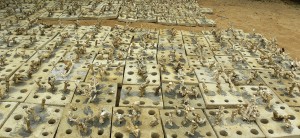Commercial Bank funds coral replanting in Hikkaduwa
View(s):A groundbreaking project to replant coral in the Hikkaduwa Marine National Park has been launched by the Department of Wildlife Conservation with funding from the Commercial Bank of Ceylon.
A first for the Department, the initiative envisages replanting an extent of 1,000 square feet in the Walduwa area of the marine park, using techniques perfected in the Philippines. The original coral in this protected area was damaged in 1998 due to the warming of the ocean due to the ‘El Niño’ southern oscillation and the tsunami of 2004, the bank said in a statement to the media.

Picture shows the 'coral tiles' that will line the sea bed.
The first phase of the project involves the production of concrete blocks of one square foot apiece with dead coral of five to six inches in height embedded on one surface. These blocks are then linked to one another and anchored to the seabed like floor tiles, creating a new coral bed in the area where the original coral was destroyed.
Once the sea water has adequately ‘cured’ the concrete blocks of toxins, live coral that has broken off naturally, will be collected from areas such as Mirissa, Matara and Unawatuna, transported under controlled conditions and affixed to the dead coral, creating a new layer of live coral that will continue to grow and attract and sustain marine life.
A spokesman for the Department of Wildlife Conservation said 700 concrete blocks would be used to create the new coral bed. Another 300 square feet of coral would be created by cementing dead coral to natural rock using a highly specialised gum. The live coral that is to be joined to the dead coral at the second stage of the project is of the Staghorn variety, which grows by two to three centimetres a year.
“With time, sand deposits will hide the concrete base of the new coral floor, and we are hopeful that a pristine bed of live coral will rise in this area, thanks to the generosity of the Commercial Bank,” the spokesman said.
This latest project supported by Commercial Bank brings even greater diversity to the Bank’s CSR portfolio, which is directed by the Commercial Bank CSR Trust with the overall objective of generating measurable and sustainable social dividends for different segments of society.
Follow @timesonlinelk
comments powered by Disqus


